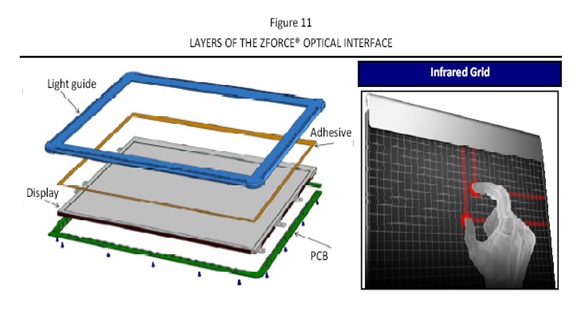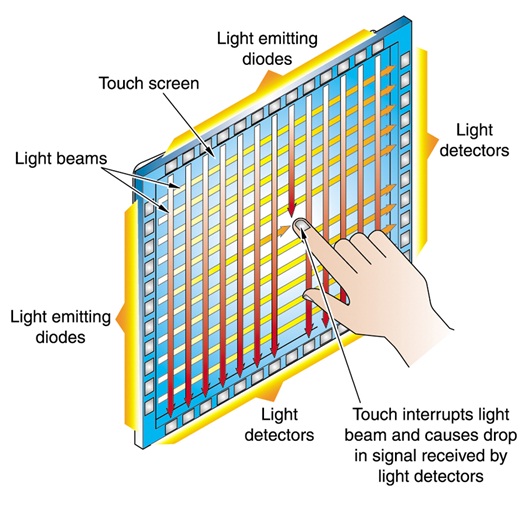





Published on Apr 02, 2024
Neonode has patented and commercialized the zForce® (an abbreviation for “zero force necessary”) touch technology, which was designed to overcome many of the limitations of today’s touchscreens.
The premise of the Company’s approach entails the projection of an infrared grid across an electronic display. As users tap, swipe, or write on the screen, zForce® detects the location of the touch based on the interruption in infrared light projecting across the screen, which translates to coordinates on the grid. The zForce® architecture and input method is believed to be unique to Neonode.
A zForce Touch Screen can be activated by multiple modes of input, including bare fingers, gloves, styluses, and (multiple simultaneous touches). It is uncommon today to find both of pens, as well as recognizes multi-touch these features innately built into the same touchscreen. The resistive touch technology used on most PDAs to recognize stylus writing works as a spot on the screen is pressed inward, causing one layer of the touchscreen to make contact with a layer beneath. This contact sends a signal to the device to recognize the touch. Although relatively low cost, resistive touchscreens do not typically allow multi-touch (swiping, gesturing)
Neonode overcomes limitations of both resistive and capacitive screens with its zForce® technology—creating a next-generation touch surface that the Company believes can be more economical as well as higher performing than either of the main technologies in use today. Currently, projected-capacitance touch screens represent the mainstream technology for multi-touch interfaces. However, zForce® also enables the convenient multi-touch features of capacitive screens but at the cost structure of more affordable resistive technologies. Further, as overviewed on, in February 2012, the Company introduced a new Multi Sense component to the zForce® technology that is intended to improve upon standard multi-touch processes.

In contrast to capacitive and resistive screens, which have microscopic circuits embedded on a glass substrate, Neonode’s controller projects a grid of infrared light beams across the display layer. Importantly, the Company’s technology is display agnostic and can be added to variety of display surfaces, including liquid-crystal display (LCD), eink, organic Light emitting diodes (OLED),and electronic paper displays (EPD).
Touch is detected as a finger or object interrupts (by obstructing or reflecting) the light beams projected across the screen surface, which identifies the X and Y coordinates of the touch. The zForce® infrared optical touchscreen relies neither on pressure nor conduction, enabling consumers to use a Neonode touchscreen barehanded or while wearing gloves, holding pens or styluses, etcetera. As illustrated in Figure 11, there is no glass substrate or glass overlay required.
In Figure11, a plastic light guide is located under the bezel on top of the display. It serves to reflect and focus light are shown attached to a around the zForce® display. LEDs and photo diodes printed circuit board (PCB) display (also shown in Figure 12). The zForce Technology pulses an infrared light across the screen at a rate of up to 120 times a second so the grid is continuously refreshed. As the user’s fingers move across the screen, the grid’s coordinates where the screen is touched are converted into mathematical algorithms in a process that is unique to Neonode. The Company holds patents worldwide related to the zForce® architecture and input method.
The newer and higher-cost capacitive technology, such as that used on Apple Inc.’s (AAPL NASDAQ) iPhone, is activated by conductive material rather than applied pressure. Electrodes in the display contact with an electrical conductor, such as a finger. Capacitive devices perform multi touch but cannot be activated by standard pointers or gloves as these are nonconductive.. As a result, many users find that their touchscreen can recognize taps from their fingers but not finger nails. In contrast, the zForce® screens offer full finger touch capabilities (e.g., gestures like “pinching” the screen to zoom in or out) as well as high-resolution pen support in the same solution
Infrared Touch Screen is a touch frame which is usually installed in front of the display screen. The frame is integrated with printed circuit board which contains a line of IR-LEDs and photo transistors hidden behind the bezel of the touch frame. Each of IR-LEDs and photo transistors is set on the opposite sides to create a grid of invisible infrared light. The bezel shields the parts from the operation environment while allowing the IR beams to pass through.
The Infrared Touch Screen controller sequentially pulses LEDs to create a grid of IR light beams. When a user touches the screen, enters the grid by a stylus which can interrupt the IR light beams, the photo transistors from X and Y axes detect the IR light beams which have been interrupted and transmit exact signals that identify the X and Y axes coordinates to the host

Neonode zForce is set to replace capacitive touch screens. Back to using infrared bezel sensing touchscreens of the past. Back in 1981, the PLATO V terminal used infrared bezel sensing touchscreens. Fast forward 31 years, we have the Neonode zForce. It does not use the electrical properties of the human body to track movement. An array of infrared LEDs are used to track where fingers on the screen are. The drawback of this kind of technology is that a raised bezel is placed around the screen. This raised bezel houses an array of infrared LEDs and sensors. The new technology has already been licensed to companies such as Sony and Barnes & Noble. It won’t be long till we see future devices from these companies to use this technology. The Swiss company has noted that power consumption is as low as 1mW at 100Hz. Battery life of tablet devices will benefit from such a new type of touchscreen. 1ms response times are quite possible with this new technology and there is little to no lag
100% light transmission (not an overlay)
Long service life
Can be scaled to any size without losing resolution
High chemical, scratch, breakage, and liquid resistance
Touch can be activated by anything including finger, gloved hand, or stylus
www.neonode.com/
en.wikipedia.org/wiki/Neonode
www.engadget.com/tag/Neonode/
| Are you interested in this topic.Then mail to us immediately to get the full report.
email :- contactv2@gmail.com |